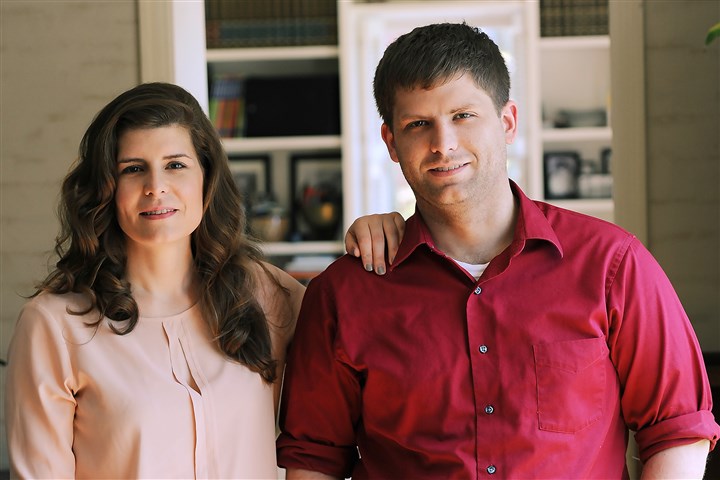By Kris B. Mamula
Pittsburgh Post-Gazette
WWR Article Summary (tl;dr) One Pittsburgh doctor is showing that women in leadership can create deep meaningful change when they have the courage to do whatever it takes solve problems. When Dr. Lisa Boyette’s brother was diagnosed with a rare disease, she abandoned her traditional medical career for a new one as a medical entrepreneur of sorts…doing whatever it takes to save her brother. For this amazing woman, failure is not an option.
Pittsburgh Post-Gazette
Lisa Boyette coveted that career — the scientist in the white coat hunched over a microscope in a university lab, floating on a river of government research money, leading to medical breakthroughs and growing prestige as her career opened up like the big sky in Georgia where she was born.
Dr. Boyette, 34, had planned a career in academic medical research, which brought her to the Thomas E. Starzl Transplantation Institute in Oakland for postdoctoral work.
Then in 2008, her little brother got sick.
So sick that a liver transplant seems inevitable for Jonathan Boyette, 27, and even that may only delay the progression of a rare disease called primary sclerosis cholangitis.
Suddenly, traditional academic medical research wasn’t nearly fast enough for Dr. Boyette. The appeal of seeing her name lead scientific articles evaporated. Even the idea of “finding a cure” for something rather than engineering real solutions seemed like a waste of time.
“I’m not interested in being famous. I’m not interested in publishing papers,” she said. “I’m interested in keeping my little brother at the Thanksgiving table.”
Dr. Boyette junked plans for a career in academic medical research to create an organization that’s designed to cure PSC.
Oakland-based Save Jon Inc., the first outfit of its kind in Pittsburgh, is a model for funding research that borrows from philanthropy, patient advocacy and industry to solve complex medical problems faster than traditional academic medical research.
“It’s a new model to accelerate bringing solutions to the market,” said Save Jon co-founder and serial entrepreneur Dietrich Stephan. “That’s the power of the organization: It spans the entire translational pipeline, from basic research through commercialization.”
Medical problems don’t come more complex than PSC: The cause is unknown; it’s rare and may actually be several diseases; and transplanting the liver, which the disease slowly destroys, sometimes only delays the return of the condition. Even if a therapy is discovered, the average cost of bringing a new drug to market is $2.6 billion and takes 15 years, according to the Tufts Center for the Study of Drug Development.
Dr. Boyette, the daughter of an accountant mother and Defense Department engineer father, has another idea. All she needs, she says, is $20 million to $25 million a year for five years.
She is assembling an international clinical research network that will raise money, support clinical trials and drug development to find a cure for the brother she calls “such an amazing man.” Tarrytown, N.Y.-based Regeneron Pharmaceuticals Inc. is collaborating by providing digital genetic slides that could guide the development of medicines.
While public sector biomedical research is focused on generating knowledge, Dr. Boyette’s idea is to approach a cure with a corporate project management mindset.
Meanwhile, Mr. Boyette’s condition remains fragile. He underwent a surgical procedure on his bile ducts after his diagnosis, which buoyed doctors at first.
“They were, like, ‘Great, he’s going to get better,’ ” said Mr. Boyette, who works in the special events department at the Smithsonian’s National Air and Space Museum in Washington, D.C. “But I didn’t.”
In the 18 months since Save Jon was formed, funding has come from people with the disease or their families and other contributors. A fundraising gala is planned for July. Now, Dr. Boyette says she has to ramp things up to reach funding goals by soliciting industry, foundations and high net-worth individuals who want to see PSC cured.
“We’re not about institution-building,” she said. “We’re building a model to accelerate the research and development process. We really want to be the hired guns in the biomedical world.”
Save Jon is modeled after the Multiple Myeloma Research Foundation, which has raised $275 million since its founding in 1998, launched 50 clinical trials and accelerated Food and Drug Administration approval of 10 drugs in the time it normally takes to get one. Not so very long ago, the only treatment for the bone cancer was radiation and pain medicine.
It’s no coincidence that MMRF president and CEO Walter Capone has been recruited to the Save Jon board.
“Patient groups are saying, ‘We want to be actively involved in the research as well,’ ” said Kenneth Kaitin, director of the Tufts Center for the Study of Drug Development in Boston. “That’s a very appealing source of funding for a lot of researchers now” in light of flat or declining federal research dollars.
Traditional academic medical research depends on getting increasingly scarce National Institutes of Health grants, which turn into lab work and journal articles and more NIH funding to keep the university research machine lubricated. The work is tedious, the process slow and often isolating.
“The traditional research model is really expensive and slow,” said Keith Lindor, dean of the College of Health Solutions at Arizona State University in Phoenix, authority on cholestatic liver disease and Save Jon board member.
“Lisa is trying to come up with a more entrepreneurial way.”
Still, the very idea of “finding” a cure for disease makes Dr. Boyette bristle.
“You don’t ‘find’ a car or ‘find’ a machine,” she said. “We do care engineering here. It’s going to change things.”














































































































































































































































































































































































